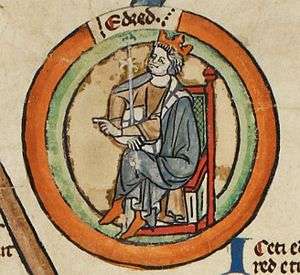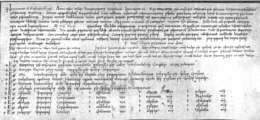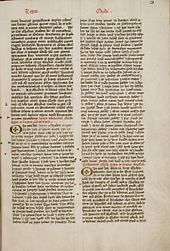Eadred
Eadred (also Edred) (923 – 23 November 955) was King of the English from 946 until his death. He was the son of Edward the Elder and his third wife Eadgifu of Kent, and a grandson of Alfred the Great. Eadred came to the throne following the assassination of his older brother, Edmund I. The chief achievement of his reign was to bring the Kingdom of Northumbria under total English control, which occurred with the defeat and expulsion of Eric Bloodaxe in 954. Eadred died at the age of 32 having never married, and was succeeded by his 15-year-old nephew, Eadwig.
| Eadred | |
|---|---|
 Eadred in the early fourteenth century Genealogical Roll of the Kings of England | |
| King of the English | |
| Reign | 26 May 946 – 23 November 955 |
| Coronation | 16 August 946 Kingston upon Thames |
| Predecessor | Edmund I |
| Successor | Eadwig |
| Born | 923 Wessex, England |
| Died | 23 November 955 (aged 31–32) Frome, Somerset |
| Burial | Old Minster, Winchester. Bones now in Winchester Cathedral |
| House | Wessex |
| Father | Edward the Elder |
Background and succession
Eadred was a son of Edward the Elder by his third marriage, to Eadgifu, daughter of Sigehelm, ealdorman of Kent.[1] He succeeded his elder brother King Edmund I (r. 939-946), who was stabbed to death at Pucklechurch (Gloucestershire), on St Augustine's Day, 26 May 946. The same year, on 16 August, Eadred was consecrated by Archbishop Oda of Canterbury at Kingston upon Thames (Surrey, now Greater London), where he appears to have received the submission of Welsh rulers and northern earls.[2]
Trouble in Northumbria

The Anglo-Saxon Chronicle for the year 946 records that Eadred "reduced all the land of Northumbria to his control; and the Scots granted him oaths that they would do all that he wanted."[3] Nevertheless, Eadred soon faced a number of political challenges to the West-Saxon hegemony in the north. Unfortunately, there are some notorious difficulties with the chronology of the events described in the historical sources, but it is clear that there were two Scandinavian princes who set themselves up as kings of Northumbria.

Óláf Sihtricson, otherwise known as Amlaíb Cuarán ('Sandal'), had been king of Northumbria in the early 940s when he became Edmund's godson and client king, but he was later driven out. He then succeeded his cousin as King of Dublin, but after a heavy defeat in battle in 947, he was once again forced to try his luck elsewhere.[4] Shortly thereafter, Olaf was back in business, having regained the kingdom of York.[5] What Eadred thought of the matter or how much sympathy he bore for his brother's godson can only be guessed at, but it seems that he at least tolerated Olaf's presence. In any event, Olaf was ousted from the kingship a second time by the Northumbrians, this time in favour of Eric son of Harald, according to MS E of the Chronicle.[6]
The other player in the game was Eric Bloodaxe, previously King of Norway from 930 to 934. After a number of successful operations elsewhere, he came to Northumbria and appears at some point to have set himself up as king. King Eadred responded harshly to the northern defectors by launching a destructive raid on Northumbria, which notably included burning the Ripon monastery founded by St. Wilfrid. Although his forces sustained heavy losses in the Battle of Castleford (as he returned home), Eadred managed to check his rival by promising the latter's supporters even greater havoc if they did not desert the foreign prince. The Northumbrians appeased the English king and paid compensation.[7]
The Historia Regum suggests that the threat of an independent Northumbrian king had come to an end in 952, when earls finally took over the helm.[8]
Health conditions and death
Towards the end of his life, Eadred suffered from a digestive malady which would prove fatal. 'Author B', the biographer and former apprentice of St Dunstan, described with vivid memory how the king sucked out the juices of his food, chewed on what was left and spat it out.[9] Eadred died at the age of 32 on 23 November (St. Clement's Day), 955, at Frome (Somerset), and was buried in the Old Minster at Winchester.[10] He died a bachelor, and was succeeded by Edmund's son Eadwig.
References
- Eadred (d. 955)
- Sawyer no. 520; John of Worcester, Chronicon ex Chronicis, 946
- Anglo-Saxon Chronicle MSS D and E, translated by Michael J. Swanton, The Anglo-Saxon Chronicles. 2nd ed. London, 2000.
- Annals of Ulster 945 and 947: CELT
- Anglo-Saxon Chronicle MS E, 949
- Anglo-Saxon Chronicle MS E, 952
- Anglo-Saxon Chronicle MS D, 948, but the Historia Regum gives 950
- Historia Regum 952
- "Eratque, proh dolor, rex Eadraedus dilectus Dunstani per omne tempus imperii sui nimium languens, ita ut refectionis tempore sorpto succo ciborum reliquam partem parumper dentibus obtritam ab ore rejecisse, et sic saepe convivantibus secum militibus foetentem nausiam exspuendo fecisset." Vita S. Dunstani § 20: p. 31
- Anglo-Saxon Chronicle MSS A, D and E, 955, MSS B and C, 956.
Bibliography
Primary sources
- Anglo-Saxon Chronicles. Edition available online.
- Historia Regum, ed. T. Arnold, Symeonis Monachi Opera Omnia. 2 vols: 2. London, 1885.
- John of Worcester, Chronicon ex Chronicis, ed. Benjamin Thorpe, Florentii Wigorniensis monachi chronicon ex chronicis. 2 vols: vol 1. London, 1848–9.
- Charters:
- Sawyer no. 1515 (AD 951 x 955). Text available from Anglo-Saxons.net. Like his grandfather King Alfred, Eadred left a written record of his will.
- Anglo-Saxon Charters, Sawyer nos. 515–580 (including S 552a, 522a, 517a-b), 1211–2, 1511.
Secondary sources Williams, Ann (2004). "Eadred (d. 955)". Oxford Dictionary of National Biography.
Further reading
Primary sources
- Chronicle of Æthelweard, ed. and tr. Alistair Campbell, The Chronicle of Æthelweard. London, 1961.
- Vita S. Dunstani ('Life of St. Dunstan'), ed. W. Stubbs, Memorials of St Dunstan, Archbishop of Canterbury. Rolls Series. London, 1874. 3-52. Available as PDF from Google Books (or from the Internet Archive here or here) and from Gallica.
- Vita S. Æthelwoldi ('Life of St. Æthelwold'), ed. and tr. Michael Lapidge and Michael Winterbottom, Wulfstan of Winchester. The Life of St Æthelwold. OMT. Oxford, 1991.
Secondary sources
- Gough, Harold. "Eadred's Charter of AD 949 and the Extent of the Monastic Estate of Reculver, Kent." St Dunstan: His Life, Times and Cult, ed. Nigel Ramsay and Margaret Sparks. Woodbridge and Rochester, NY: Boydell, 1992. 89–10.
- Keynes, Simon (1994). "The 'Dunstan B' Charters". Anglo-Saxon England. 23: 165–93. doi:10.1017/s026367510000452x.
- Sawyer, P. "The last Scandinavian rulers of York." Northern History 31 (1995): 39–44.
- Stafford, Pauline (1989). Unification and Conquest. A Political and Social History of England in the Tenth and Eleventh Centuries. London.
- Stenton, Frank Merry. Anglo-Saxon England. 3d ed. Oxford, 1971. 360–3.
External links
| Wikimedia Commons has media related to Eadred. |
- Eadred 16 at Prosopography of Anglo-Saxon England
- Coins issued by King Eadred at Early Medieval Corpus of Coin Finds
- More images are available on the web, such as here and here
| Regnal titles | ||
|---|---|---|
| Preceded by Edmund |
King of the English 946–955 |
Succeeded by Eadwig |
| Preceded by Eric Bloodaxe |
King of Northumbria As King of the English 954–955 |
Title merged in English crown |